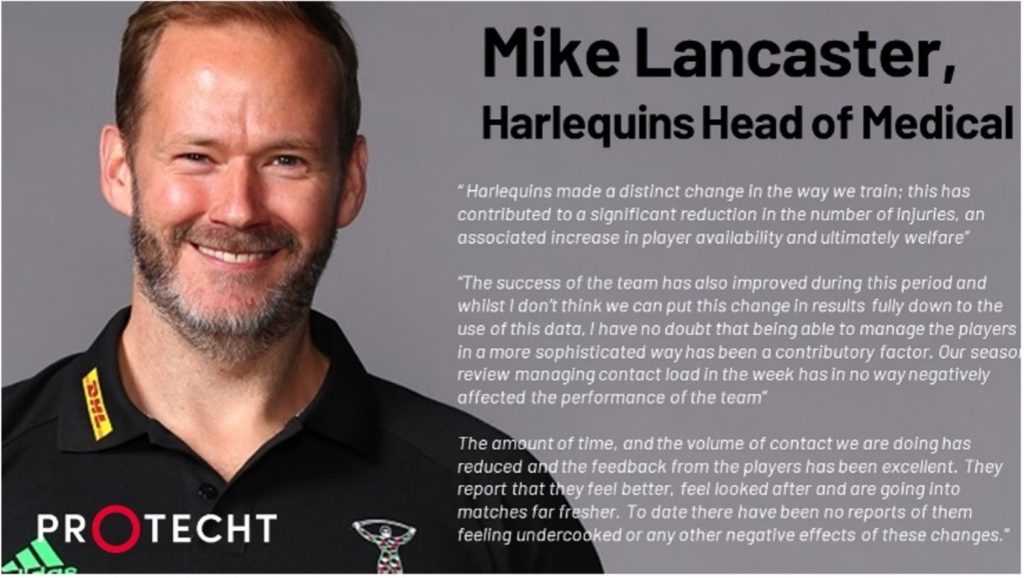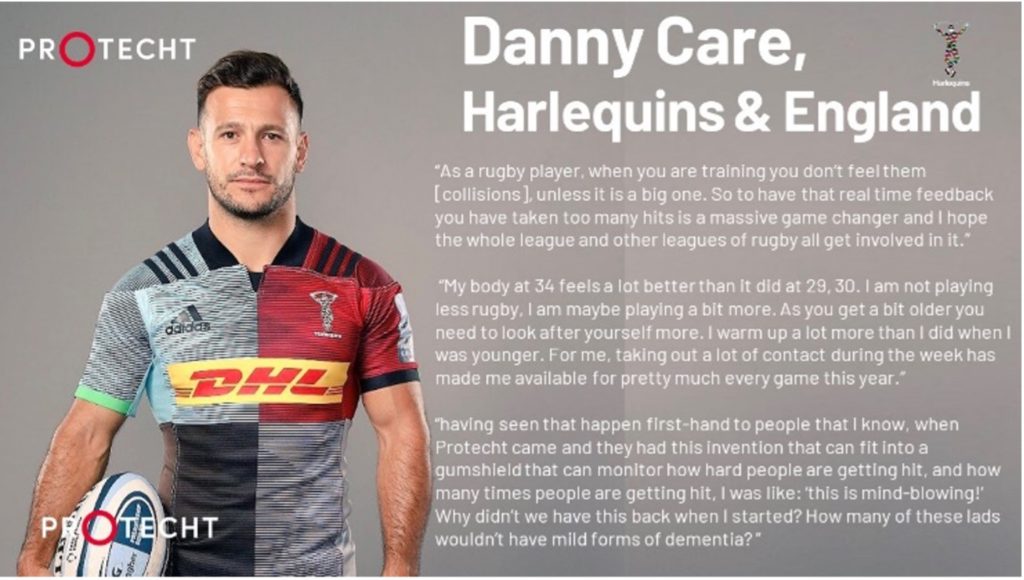

We are delighted to be able to confirm that SWA have renewed our partnerships with Harlequins and Gloucester in conjunction with our partners OPRO for the coming season. Both teams continue to use the PROTECHT system across their entire squad and we have enjoyed working with two very forward thinking CEOs in Lance Bradley and Laurie Dalrymple.
Alex Brown, Gloucester COO commented “We are really pleased to continue our long-standing partnership with PROTECHT and to be able to supply our players with industry leading mouthguards.
“The technology provided by PROTECHT is second-to-none, and the data that we are able to accurately monitor on a day-to-day basis means that we can manage the players contact levels in the week and during the game.
“With concussion management being a key focus across the sport, this partnership enables us to put player welfare at the forefront of everything we do.”
Harlequins have discussed in both the Telegraph and last week in the Guardian how the PROTECHT system has helped them revolutionise their contact training which ultimately helped improve injury rates at the club and player availability.
Harlequins CEO Laurie Dalrymple said: “We are delighted to extend our thriving partnership with SWA. It has been well publicised how beneficial and effective our work with PROTECHT has been for helping our Medical and Strength and Conditioning departments manage player workload, and we’ve seen a direct link to performance on the pitch.
“Their gumshield technology is industry-leading when it comes to load management and managing player contact levels throughout the week.
“Player welfare is at the forefront of our thoughts at Harlequins, and with the risks that come with concussion in contact sport, our partnership with SWA helps us manage and mitigate risk with greater precision than ever.”
We are also pleased to see another of our partners, St Helens Rugby League progress into the Grand Final this weekend and we wish them well in their pursuit to retain their Superleague Championship. The season has already reached its conclusion for Salford and we have some unique and performance enhancing insights that we can share soon from working with our Rugby League partners. Some general themes are discussed in our Sport Scientist Tom McArdle’s blog below with greater detail being provided in the next couple of months.

In light of World Rugby’s announcement regarding new contact load guidance we wanted to remind you how the PROTECHT tool can help you to better manage your players, decrease injuries and ultimately improve the performance of your team.
We are really pleased that these guideline reflect the work we did for World Rugby and the RFU into the elite game and that they have adopted our ideologies, concepts and the language that we have been using and discussing with our customers for well over a year. Whilst the guidelines are a positive step forward however, we understand that elite teams need to work to a much greater level of detail and have full visibility on the loadings placed on the athletes in their environment.
The PROTECHT system provides live feedback to the touchline regarding the number and intensity of each and every collision. This immediate feedback allows practitioners to make interventions that support the welfare of the players and prime them for competition in training by ensuring they are contact conditioned, yet not over exposed, fatigued and at greater risk of injury. The detail provided goes much deeper than a total amount of time spent in a drill by giving exact figures on what each and every athlete has been exposed to.
We have also been really encouraged by the uptake by players of the new slimline mouthguards. By embracing the feedback from our customers and working closely with our mouthguard partner, Opro to make the guards even smaller and thinner, we are delighted to see the results really making a difference to them. Even players who have never worn mouthguards are now wearing these.
This summer, Premier League football announced new heading in training guidelines regarding the amount of headers that should take place in any given training week. The announcement follows a study that we have completed with a cohort of players from Manchester City’s U18s and women’s teams and Liverpool FC’s U23s and U18s teams who were also fitted with the new slimline Opro+ mouthguards to measure accelerations involved in heading the football.
The guidance will apply to clubs in the Premier League, EFL, Barclays Women’s Super League, FA Women’s Championship, the National system from steps 1-4 and the England National team.
We are delighted that the study will be scaled up for the new season.
Please take a look at the articles below that show how we have helped our customers to improve player welfare whilst also drive team performance. To follow up with us on any of these topics or indeed any other areas that interest you, the contact details for the team are included below.
It has been a pretty busy and progressive period on the science front with two particular key events at the forefront.
The first is the paper that features in this month’s newsletter “contact events in rugby union and the link to reduced cognition for impaired redox-regulation of cerebrovascular function”.
Though contact events were only measured through count, this paper shows the beginnings of a better understanding of the effects of contact and its impact on the brain. The ability to objectively measure contact events will further help to answer these questions and direct focus on the issues at hand.
The second major update was the announcement and release of the World Rugby contact guidelines. These guidelines recommended a limit on the contact time spent in the week to 3 areas; full contact training, controlled contact training and live set piece contact. Though these are not the finished product, they again provide the foundations to build on. A system that objectively monitors contact, takes these guidelines a step further in their natural progression.
This is where the PROTECHT system with its live capabilities really comes to the forefront. Being able to measure, manage and manipulate contact in real time allows us to optimise athlete readiness and availability which will ultimately improve overall squad outcome. The system is effective because it was developed by practitioners, for practitioners. Not only are we at the forefront of technology and research, where we work with governing bodies and universities to answer key questions outlined previously, but the biggest factor is that as practitioners looking after athletes, we understand the importance of measuring contact and it’s impact on recovery, fatigue, welfare and performance.
This is really summed up from by a tweet from a leading researcher at La Trobe University in Melbourne, Australia about the work we have done with Harlequins reported in the recent guardian article “This is how to use technology to assist and reduce athlete impact exposure, rather than recording data to work out how much impact causes concussion”.
With Super League season drawing to a close with only the play off matches remaining, we are pleased that one of our client clubs St Helens have made it through to the Grand Final. With a more condensed fixture schedule this season due to Covid-19 constraints, it has been really interesting working with our 2 Super League clubs monitoring contact load in both training and matches.
We started out with Salford Red Devils for preseason preparations back in February of this year The initial objective was to understand what the match demands of the sport looked like and how players responded to these demands as PROTECHT has been the first to collect this type of data in rugby league. We already understood what light, moderate and strong intensity impacts looked like due to several years’ worth of data from elite rugby union and other sports, and this provided a vital basis for player welfare monitoring of training and games. With a very different style of game we anticipated these volume and intensity metrics to differ and therefore inform training practices and recovery strategies differently.
The difference between union and league match styles has definitely been an important factor in the differences seen in the data. With the defence line retreat law in rugby league we see greater velocities into contact which has contributed to an increase in average impact intensity. Additionally, with a greater number of 2/3 man tackles and a greater upper body focus this has again contributed to the greater impact intensities seen in competition demands.
Understanding the different positional and individual load averages of the players allows week to week loads to be monitored and players subsequent recovery and early week rugby to be a reflection of this.
What we have also observed through analysis of positional sub groups was that Middles (Props, Back Row and Loose forwards) were exposed to the greatest total volume loads, followed by Adjustables (Half Backs and Hooker) and then Outside backs (Full Back, Centre, Wings). By understanding these differences, delving deeper into each metric for individual positions and then analysing the event types for which these impacts most commonly occur we are now assisting our clubs in preseason planning in order to ensure contact loading is prescribed more specifically for the individual demands and the competition specific movement demands to which these impacts occur.
As well as Salford, St Helens have also been using the PROTECHT system this season and with Challenge cup success back in July, all focus is on the Super league with a semi-final match vs Leeds Rhinos last week. Our rugby league sport scientist Ben Akin has immersed himself in the St Helens environment for the second half of this season brilliantly and all at PROTECHT wish Saints the best of luck in the Grand Final this weekend.

Privacy Policy
Copyright 2020 Sports & Wellbeing Analytics Limited – All Rights Reserved
Website by Waters